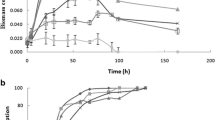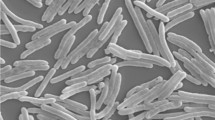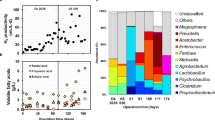Abstract
The fermentation of waste gases rich in carbon monoxide using acetogens is an efficient way to obtain valuable biofuels like ethanol and butanol. Different experiments were carried out with the bacterial species Clostridium carboxidivorans as biocatalyst. In batch assays with no pH regulation, after complete substrate exhaustion, acetic acid, butyric acid, and ethanol were detected while only negligible butanol production was observed. On the other side, in bioreactors, with continuous carbon monoxide supply and pH regulation, both C2 and C4 fatty acids were initially formed as well as ethanol and butanol at concentrations never reported before for this type of anaerobic bioconversion of gaseous C1 compounds, showing that the operating conditions significantly affect the metabolic fermentation profile and butanol accumulation. Maximum ethanol and butanol concentrations in the bioreactors were obtained at pH 5.75, reaching values of 5.55 and 2.66 g/L, respectively. The alcohols were produced both from CO fermentation as well as from the bioconversion of previously accumulated acetic and butyric acids, resulting in low residual concentrations of such acids at the end of the bioreactor experiments. CO consumption was often around 50 % and reached up to more than 80 %. Maximum specific rates of ethanol and butanol production were reached at pH 4.75, with values of 0.16 g/h*g of biomass and 0.07 g/h*g of biomass, respectively, demonstrating that a low pH was more favorable to solventogenesis in this process, although it negatively affects biomass growth which does also play a role in the final alcohol titer.



Similar content being viewed by others
References
Abdehagh N, Tezel FH, Thibault J (2014) Separation techniques in butanol production: Challenges and developments. Biomass Bioenerg 60:222–246. doi:10.1016/j.biombioe.2013.10.003
Abubackar HN, Veiga MC, Kennes C (2011) Biological conversion of carbon monoxide: rich syngas or waste gases to bioethanol. Biofuels Bioprod Biorefin 5:93–114. doi:10.1002/bbb.256
Abubackar HN, Veiga MC, Kennes C (2015) Carbon monoxide fermentation to ethanol by Clostridium autoethanogenum in a bioreactor with no accumulation of acetic acid. Bioresource Technol 186:122–127. doi:10.1016/j.biortech.2015.02.113
Ahmed A, Lewis RS (2007) Fermentation of biomass-generated synthesis gas: effects of nitric oxide. Biotechnol Bioeng 97:1080–1086. doi:10.1002/bit.21305
Balat M, Balat H (2009) Recent trends in global production and utilization of bio-ethanol fuel. Appl Energ 86(11):2273–2282. doi:10.1016/j.apenergy.2009.03.015
Bengelsdorf FR, Straub M, Dürre P (2013) Bacterial synthesis gas (syngas) fermentation. Environ Technol 34:1639–1651. doi:10.1080/09593330.2013.827747
Bruant G, Lévesque M-J, Peter C, Guiot SR, Masson L (2010) Genomic analysis of carbon monoxide utilization and butanol production by Clostridium carboxidivorans strain p7T. PLoS ONE 5(9):e13033. doi:10.1371/journal.pone.0013033
Bredwell MD, Worden RM (1998) Mass-transfer properties of microbubbles. 1. Experimental studies. Biotechnol Prog 14(1):31–38. doi:10.1021/bp970133x
Dürre P (2007) Biobutanol: an attractive biofuel. Biotechnol J 2:1525–1534. doi:10.1002/biot.200700168
Gowen CM, Fong SS (2011) Applications of systems biology towards microbial fuel production. Trends Microbiol 10:516–524. doi:10.1016/j.tim.2011.07.005
Han B, Gopalan V, Ezeji TD (2011) Acetone production in solventogenic Clostridium species: new insights from non-enzymatic decarboxylation of acetoacetate. Appl Microbiol Biotechnol 91:565–576. doi:10.1007/s00253-011-3276-5
Henstra AM, Sipma J, Rinzema A, Stams AJM (2007) Microbiology of synthesis gas fermentation for biofuel production. Curr Opin Biotechnol 18:200–206. doi:10.1016/j.copbio.2007.03.008
Jin C, Yao M, Liu H, Lee CFF, Ji J (2011) Progress in the production and application of n-butanol as a biofuel. Renew Sust Energy Rev 15:4080–4016. doi:10.1006/j.rser.2011.06.001
Jin Y, Guo L, Veiga MC, Kennes C (2009) Optimization of the treatment of carbon monoxide-polluted air in biofilters. Chemosphere 74:332–337. doi:10.1016/j.chemosphere.2008.10.001
Jones DT, Woods DR (1986) Acetone–butanol fermentation revisited. Microbiol Rev 50:484–524
Kennes C, Veiga MC (2001) Bioreactors for waste gas treatment. Kluwer Academic Publishers, Dordrecht, The Netherlands, 312 pp
Kennes C, Veiga MC (2013) Air pollution prevention and control: Bioreactors and bioenergy. J. Wiley, Chichester, UK, 549 pp
Kennes D, Abubackar HN, Diaz M, Veiga MC, Kennes C (2016) Bioethanol production from biomass: carbohydrate vs syngas fermentation. J Chem Technol Bioetchnol 91:304–317
Klasson KT, Ackerson CMD, Clausen EC, Gaddy JL (1992) Biological conversion of coal and coal-derived synthesis gas. Fuel 72:1673–1678. doi:10.1016/0016-2361(93)90354-5
Lee SY, Park JH, Jang SH, Nielsen LK, Kim J, Jung KS (2008) Fermentative butanol production by clostridia. Biotechnol Bioeng 101:209–228. doi:10.1002/bit.22003
Liu S, Qureshi N (2009) How microbes tolerate ethanol and butanol. New Biotechnol 26:117–121. doi:10.1016/j.nbt.2009.06.984
Liou JSC, Balkwill DL, Drake GR, Tanner RS (2005) Clostridium carboxidivorans sp. nov., a solvent-producing clostridium isolated from an agricultural settling lagoon, and reclassification of the acetogen Clostridium scatologenes strain SL1 as Clostridium drakei sp. nov. Int J Syst Evol Microbiol 55:2085–2091. doi:10.1099/ijs.0.63482-0
Mohammadi M, Najafpour GD, Younesi H, Lahijani P, Uzir MH, Mohamed AR (2011) Bioconversion of synthesis gas to second generation biofuels: a review. Renew Sust Energy Rev 15:4255–4273. doi:10.1016/j.rser.2011.07.124
Ndaba B, Chiyanzu I, Marx S (2015) n-Butanol derived from biochemical and chemical routes: A review. Biotechnol Reports 8:1–9. doi:10.1016/j.btre.2015.08.001
Phillips JR, Atiyeh HK, Tanner RS, Torres JR, Saxena J, Wilkins MR, Huhnke RL (2015) Butanol and hexanol production in Clostridium carboxidivorans syngas fermentation: Medium development and culture techniques. Bioresour Technol 109:114–121. doi:10.1016/j.biortech.2015.04.043
Tanner RS (2007) Cultivation of bacteria and fungi. In: Hurst CJ, Crawford RL, Garland JL, Lipson DA, Mills AL, Stetzenbach LD (eds) Manual of Environmental Microbiology. ASM Press, Washington, D.C, pp. 69–78
Shaw AJ, Podkaminer KK, Desai SG, Bardsley JS, Rogers SR, Thorne PG, Hogsett DA, Lynd LR (2008) Metabolic engineering of a thermophilic bacterium to produce ethanol at high yield. Proc Natl Acad Sci U S A 105:13769–13774. doi:10.1073/pnas.0801266105
Shen Y, Brown R, Wen Z (2014) Syngas fermentation of Clostridium carboxidivorans P7 in a hollow fiber membrane biofilm reactor: evaluating the mass transfer coefficient and ethanol production performance. Biochem Eng J 85:21–29. doi:10.1016/j.bej.2014.01.010
Schugerl K (2000) Integrated processing of biotechnology products. Biotechnol Adv 18:581–599. doi:10.1016/S0734-9750(00)00051-3
Ukpong MN, Atiyeh HK, De Lorme JM, Liu K, Zhu X, Tanner RS, Wilkins MR, Stevenson BS (2012) Physiological response of Clostridium carboxidivorans during conversion of synthesis gas to solvents in a gas-fed bioreactor. Biotechnol Bioeng 109:2720–2728. doi:10.1002/bit.24549
Wallner T, Miers SA, McConnell S (2009) A comparison of ethanol and butanol as oxygenates using a direct-injection, spark-ignition engine. J Eng Gas Turbines Power 131:032802. doi:10.1115/1.3043810
White D (2007) The physiology and biochemistry of prokaryotes. Oxford University Press, New York, 628 pp
Acknowledgments
This research was financially supported by the Spanish Ministry of Economy and Competitiveness (MINECO) as well as European FEDER funds, through project CTM2013-45581-R.
Author information
Authors and Affiliations
Corresponding author
Ethics declarations
This study was financed by the Spanish Ministry of Economy and Competitiveness (MINECO) and through European FEDER funds. All authors declare that they have no conflict of interest. This article does not contain any studies with human participants or animals performed by any of the authors.
Rights and permissions
About this article
Cite this article
Fernández-Naveira, Á., Abubackar, H.N., Veiga, M.C. et al. Efficient butanol-ethanol (B-E) production from carbon monoxide fermentation by Clostridium carboxidivorans . Appl Microbiol Biotechnol 100, 3361–3370 (2016). https://doi.org/10.1007/s00253-015-7238-1
Received:
Revised:
Accepted:
Published:
Issue Date:
DOI: https://doi.org/10.1007/s00253-015-7238-1




